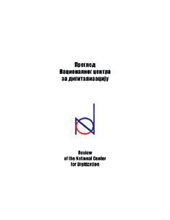Issues
Review of the National Center for Digitization
Publisher: Faculty of Mathematics, University of Belgrade
ISSN: 1820-0109
Issue: 44
Year: 2024

STATUS OF SERBIAN CULTURAL HERITAGE IN THE REPUBLIC OF CROATIA ON GOOGLE MAPS
Vladimir Živanović
Abstract
This work analyses the current status of various locations on Google Maps that are relevant for the cultural and religious heritage of Serbs in the Republic of Croatia.
1 – 13
SOLDIERS' ROADSIDE MONUMENTS IN THE COMMUNITY OF ARILJE
Zoran Cvetković
Keywords: perished soldiers, cenotaphs, roadside monuments, Serbia, First World War.
Abstract
Starting in 1912, Serbia was compelled to take part in three consecutive wars: The First and The Second Balkan Wars, and The First World War. In each war, the number of civilian and military casualties was extremely high in comparison to the total population. Soldiers perished in battles, during the retreat through Albania, in enemy camps, and in hospitals where they were being treated for war wounds and severe epidemics. The deceased were seldom buried in their hometowns.
Most often, they remained on battlefields, military cemeteries, and cemeteries of enemy camps. Therefore, their families frequently constructed specific monuments to keep a spiritual bond with their perished ones and to pay tribute to them. These memorials, commonly referred to as cenotaphs, were empty graves, typically placed along roads. In Serbia, they were known as "krajputaš", meaning a monument beside the road. This paper presents research results on the roadside military monuments discovered and documented throughout the villages of Arilje, a community in Western Serbia.
Most often, they remained on battlefields, military cemeteries, and cemeteries of enemy camps. Therefore, their families frequently constructed specific monuments to keep a spiritual bond with their perished ones and to pay tribute to them. These memorials, commonly referred to as cenotaphs, were empty graves, typically placed along roads. In Serbia, they were known as "krajputaš", meaning a monument beside the road. This paper presents research results on the roadside military monuments discovered and documented throughout the villages of Arilje, a community in Western Serbia.
14 - 27
ROLE OF PROGRAMMING LANGUAGES IN DIGITALIZATION
Dušan Tošić
Keywords: programming languages, digitalization,genealogical tree.
Abstract
The first high-level programming language was FORTRAN and was created in 1957. Since then, a large number of programming languages have been created. The time of creation of some of them, as well as their mutual relationship, can be described by a genealogical tree. On the genealogical tree that we used, 4 periods in the development of programming languages were distinguished, and in each period several of the most important languages were chosen. 14 most significant programming languages were selected (as chosen by the author of this work), and the main criterion was: popularity and influence on development of other languages. For each of the selected languages, some characteristics are briefly mentioned, as well as their importance for digitalization.
28 - 37